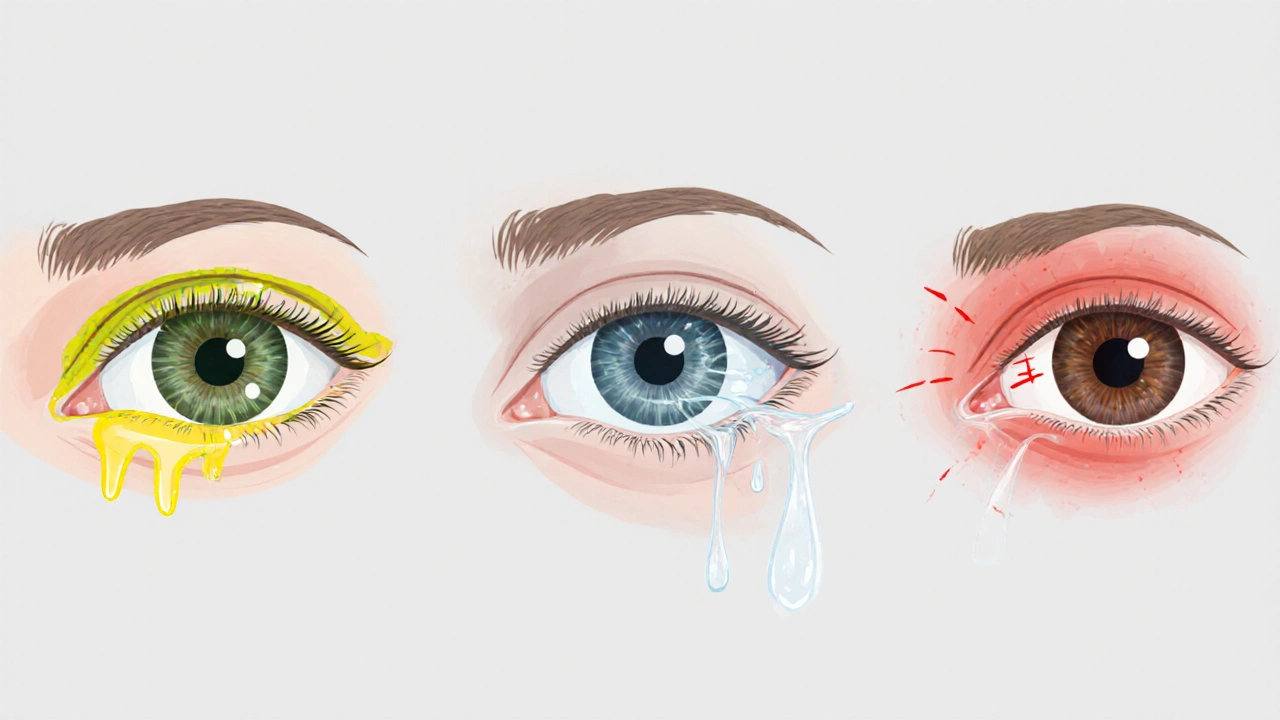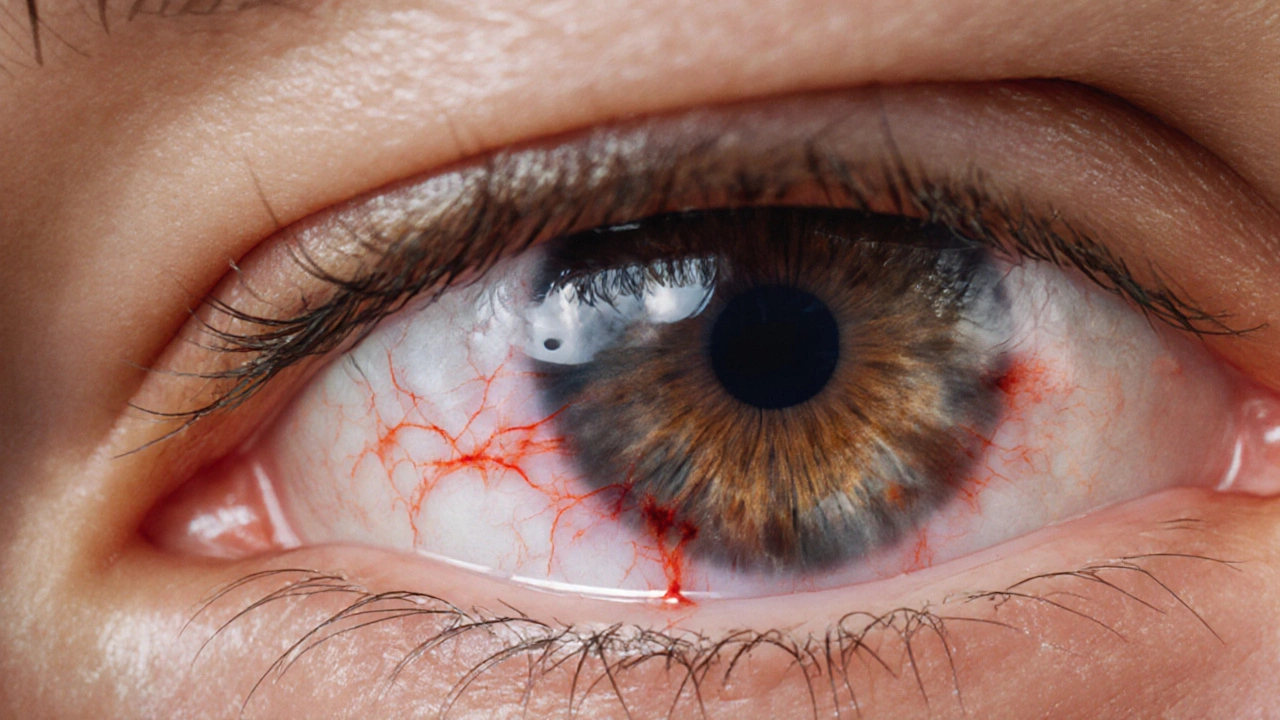Conjunctivitis Symptom Checker
Symptom Assessment
Select all symptoms you're experiencing to identify your potential type of conjunctivitis.
Your Likely Diagnosis
When your eyes turn bright red, you might think it’s just irritation, but often the culprit is Conjunctivitis is a common inflammation of the thin membrane that covers the white part of the eye and the inner eyelid.It causes redness, itching, discharge and can be contagious. Most people know it as “pink eye,” and it’s one of the top reasons doctors see patients for eye problems.
Key Takeaways
- Conjunctivitis is the main reason behind sudden eye redness.
- Three major types-bacterial, viral, and allergic-have distinct causes and treatments.
- Redness alone isn’t enough to diagnose; look for discharge, itching, and pain.
- Antibiotic drops work only for bacterial forms; viral cases need time and hygiene.
- Good hand‑washing and avoiding contact lenses during infection stop the spread.
What Is Conjunctivitis?
The medical term Conjunctivitis describes inflammation of the conjunctiva, the clear sheet that lines the inside of the eyelids and covers the eyeball.
Inflammation can be triggered by microbes, allergens, or even irritants like smoke. The swollen blood vessels behind the thin tissue give the eye its characteristic pink or red hue.
Why Does It Cause Eye Redness?
In a healthy eye, tiny blood vessels lie just beneath the transparent conjunctiva. When the tissue inflames, those vessels dilate and leak, turning the white of the eye bright red.
We’ll call this phenomenon eye rednessthe visible sign of increased blood flow and irritation in the conjunctiva. The more severe the inflammation, the deeper the redness.

Types of Conjunctivitis
Not all pink eye is the same. Below is a quick comparison of the three most common forms.
| Type | Typical Cause | Contagious? | Common Symptoms | Usual Treatment |
|---|---|---|---|---|
| Bacterial conjunctivitiscaused by bacteria such as Staphylococcus aureus | Bacteria | Yes, 1‑2days after symptoms appear | Thick yellow/green discharge, crusting overnight | Antibiotic eye dropse.g., erythromycin or fluoroquinolones |
| Viral conjunctivitisoften linked to adenovirus | Virus | Yes, highly contagious for 7‑14days | Watery discharge, burning sensation, often starts in one eye | Supportive care (cold compress, lubricating drops); no antibiotics needed |
| Allergic conjunctivitistriggered by pollen, pet dander, or cosmetics | Allergen | No | Intense itching, redness, watery discharge, often both eyes | Antihistamine eye dropse.g., olopatadine |
Spotting the Signs
Redness is just the tip of the iceberg. Keep an eye out for these clues:
- Discharge color - clear/watery (viral or allergic) vs. thick yellow/green (bacterial).
- Itching - a hallmark of allergic cases.
- Swelling of the eyelids.
- Sensitivity to light (photophobia) - more common with viral infections.
- Feeling of a foreign body in the eye.
If you notice any pain, vision changes, or intense light sensitivity, it’s time to get professional help.
When to See an Ophthalmologist
Most mild pink eye clears up with home care, but certain red‑flag symptoms demand a specialist. Ophthalmologista medical doctor specialized in eye diseases should examine you if:
- Symptoms last longer than 10days without improvement.
- Vision becomes blurry or you see halos around lights.
- You have severe pain, intense swelling, or a high fever.
- You wear contact lenses and notice any irritation - lenses should be removed immediately.

Treating at Home
Most cases of conjunctivitis can be managed with simple steps, but the right treatment depends on the type.
- Wash your hands frequently. Use soap for at least 20 seconds before and after touching your eyes.
- Apply a cold compress. Soak a clean cloth in cool water, wring out excess, and place over closed eyes for 5‑10 minutes to soothe irritation.
- Use the appropriate eye drops:
- For bacterial forms, antibiotic eye dropssuch as erythromycin ointment are prescribed for 5‑7days.
- Viral infections don’t need antibiotics; artificial tears or lubricating drops keep the eye moist.
- If allergies are the cause, antihistamine eye dropslike olopatadine reduce itching and redness.
- For rare viral strains such as herpes simplex, a doctor may prescribe antiviral eye dropse.g., trifluridine for herpes virus.
- Avoid contact lens wear. Toss out any lenses used during the infection and clean the case thoroughly.
- Discard contaminated cosmetics. Mascara, eyeliner, and eye makeup can harbor bacteria.
Prevention Tips
Stopping pink eye before it starts saves you a lot of discomfort.
- Never share towels, pillowcases, or eye makeup.
- Disinfect surfaces-doorknobs, phones, and bathroom sinks-especially if a household member is ill.
- Replace eye drops every month; older solutions can become breeding grounds for microbes.
- If you’re prone to allergies, keep windows closed during high pollen counts and use air filters.
- Regularly replace contact lenses as directed and maintain a clean lens case.
Common Myths Debunked
Myth 1: “All pink eye is contagious.”
Fact: Only bacterial and viral forms spread easily. Allergic conjunctivitis is not contagious.
Myth 2: “Antibiotics cure every pink eye.”
Fact: Antibiotics only work on bacterial infections; misuse can lead to resistance.
Myth 3: “If it’s not painful, it’s not serious.”
Fact: Some viral cases are painless yet still require isolation to protect others.
Frequently Asked Questions
Can I wear makeup while I have pink eye?
It’s best to stop using eye makeup until the redness and discharge fully clear. Mascara and eyeliner can trap bacteria and re‑infect the eye.
How long does viral conjunctivitis stay contagious?
Most viral cases remain contagious for 7‑14days, or until the eye’s discharge stops. Hand hygiene is the single most effective control.
Are there over‑the‑counter drops for pink eye?
Artificial tears and lubricating drops are safe OTC options for viral or allergic forms. Antibiotic or antiviral drops require a prescription.
Should I stay home from work or school?
Yes, especially with bacterial or viral conjunctivitis. Keep a distance of at least 24hours after starting treatment before returning to a shared environment.
Can pink eye cause permanent damage?
Rarely. Prompt treatment and avoiding rubbing the eyes usually prevent scarring. Persistent pain, vision loss, or intense light sensitivity warrants urgent medical attention.


11 Comments
Rich MartinOctober 12, 2025 AT 23:13
If you think eye redness is just a random nuisance, you’re ignoring the deeper interplay of cause and effect that governs our bodies.
Buddy SloanOctober 13, 2025 AT 00:13
I’ve been there, that gritty feeling can really freak you out 😟 but the good news is most cases clear up with simple steps like hygiene and drops.
Deidra MoranOctober 13, 2025 AT 01:13
The mainstream narrative conveniently downplays the covert role of industrial pollutants and engineered pathogens in the surge of conjunctivitis cases, a fact that the vested interests are desperate to keep hidden.
Zuber ZuberkhanOctober 13, 2025 AT 02:13
While it’s easy to get swept up in alarmist headlines, most eye inflammation stems from everyday irritants; focusing on proper hand‑washing and lens care usually neutralizes the threat.
Tara NewenOctober 13, 2025 AT 03:13
Americans have the best ophthalmologic resources, so if you’re suffering from pink eye you should consult a US‑based specialist rather than rely on dubious foreign advice.
Amanda DevikOctober 13, 2025 AT 04:13
Conjunctival hyperemia is the hallmark of ocular surface inflammation, a physiological response orchestrated by vasodilation and cytokine release. The etiopathogenesis diverges into bacterial, viral, and allergic phenotypes, each with distinct microbiological or immunological signatures. Bacterial strains such as Staphylococcus aureus produce proteolytic enzymes that compromise epithelial integrity, leading to exudate accumulation. Viral agents, particularly adenovirus serotypes, exploit mucosal entry points and propagate via lacrimal secretions, accounting for the high transmissibility observed in communal settings. Allergic conjunctivitis is mediated by IgE‑driven mast cell degranulation, releasing histamine and prostaglandins that precipitate pruritus and vasodilation. Clinicians employ slit‑lamp biomicroscopy to differentiate discharge viscosity, follicular hyperplasia, and papillary hypertrophy, thereby guiding therapeutic algorithms. Empirical treatment with fluoroquinolone ophthalmic solutions is indicated for confirmed bacterial involvement, whereas antiviral acyclovir is reserved for herpetic etiology. Supportive care, including preservative‑free artificial tears and cold compresses, remains the cornerstone for viral and allergic variants. Patient education on contact lens hygiene, hand hygiene, and environmental allergen avoidance dramatically reduces recurrence rates. Moreover, systemic antihistamines may synergize with topical agents to attenuate the allergic cascade. In refractory cases, immunomodulatory agents such as cyclosporine ophthalmic emulsion can be escalated. The prognosis is favorable when timely intervention curtails corneal complications and prevents secondary bacterial superinfection. It is imperative to monitor for visual acuity changes, as keratitis secondary to chronic conjunctivitis can jeopardize sight. Finally, interdisciplinary collaboration with allergists and infectious disease specialists optimizes comprehensive management. Adherence to the prescribed regimen ensures rapid resolution and limits public health burden.
Mr. Zadé MooreOctober 13, 2025 AT 05:13
Don't be fooled by natural remedies; only evidence‑based antibiotics will eradicate bacterial pink eye.
Brooke BevinsOctober 13, 2025 AT 06:13
Hang in there, the itching can be brutal but it'll pass soon 😊 keep those cool compresses handy.
Vandita ShuklaOctober 13, 2025 AT 07:13
You’re overlooking the fact that most over‑the‑counter drops lack preservative‑free formulations, which actually worsen ocular surface inflammation.
Samantha GavrinOctober 13, 2025 AT 08:13
There’s a hidden agenda behind the push for certain OTC eye drops – big pharma subtly steers consumers toward products that lock them into recurring purchases.
NIck BrownOctober 13, 2025 AT 09:13
Honestly, if you’re still debating whether to wash your hands, you’re missing the point; basic hygiene stops pink eye before it even starts.